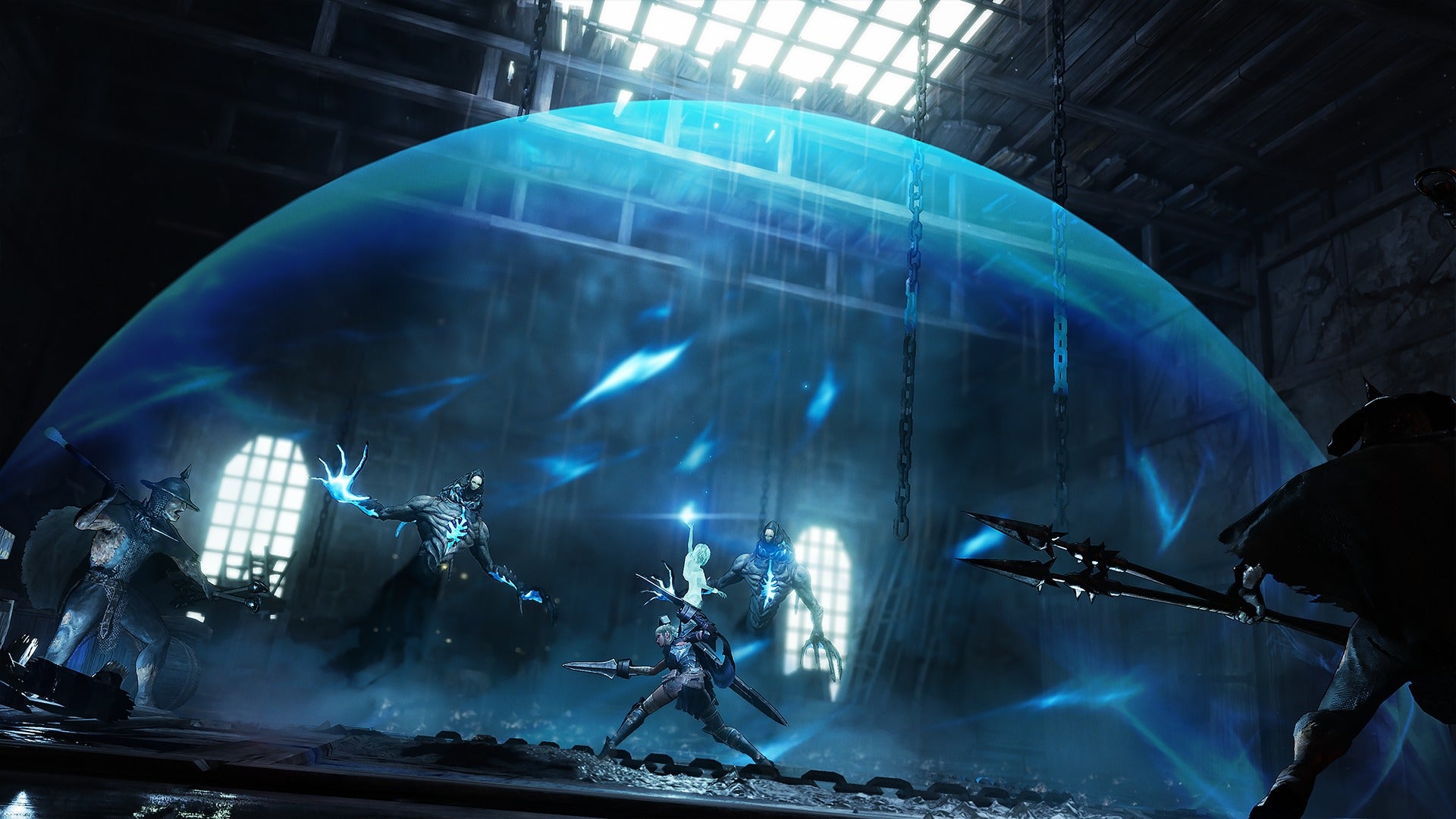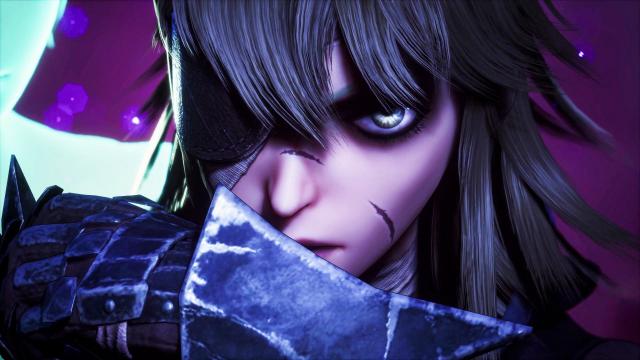In the midst of the fall gaming season, it’s very easy to lose track of games that aren’t the new hotness from big-name studios or that haven’t received enough advertising to catch one’s attention. Despite this reality, one dark action-adventure game managed to not only capture my attention but also to exceed my expectations, proving itself much more than just another derivative game paying homage to its contemporaries.
Soulstice, by Reply Game Studios, is a hack-and-slash action game. You play as both Briar, a stoic swordswoman suffering from a demonic curse that threatens to overtake her, and her sister Lute, a ghost-like being who can conjure up barriers and cast beams of light to protect her sister from enemies. Their mission is to seal the sky-beam-like tear forming in the middle of a war-torn kingdom and defeat the townspeople who’ve transformed into monsters under the tear’s influence. Basically, you might have trouble not thinking of Soulstice as akin to the Berserk manga with a dash of Claymore.
And yes, the comparison to those anime is apt. On paper, you might also draw parallels between Soulstice and other stylish action games in which the heroes battle hordes of enemies from other realms, games like Bayonetta and Devil May Cry. However, Soulstice distinguishes itself from those games by telling a compelling story that doesn’t take a backseat to its combat.
Much like its contemporaries, Soulstice’s combat features light and heavy attacks, a multitude of weapons you can seamlessly switch between, a wealth of Lovecraftian-inspired bosses for you to rip and tear into, and a temporary overpowered state where you deal even more damage to enemies. Where it deviates in both its gameplay and the emotional hook of its story is with Briar’s sister, Lute, who serves as the emotional compass steering Soulstice away from being a mundane copy of older hack-and-slash games.
Initially, Lute dragging her specter-like feet at the carnage she and her sister must trudge through makes it feel like the game is setting her up to be yet another annoying, pacifistic character you have to escort everywhere. However, as it turns out, her inclusion in the game does more than give it a compelling emotional core. It also makes the combat feel fresh and unique.

When I think of a hack-and-slash game, what often comes to mind is the power fantasy of quickly dispensing of your foes, often with the help of your overpowered, Devil Trigger-type move set. In Soulstice, however, Briar’s Berserker state works like a candle burning off at both ends. While its flame burns brilliantly, it doesn’t live as long. Much like any person playing a hack-and-slash game and unleashing their character’s full destructive potential for the first time, Briar marvels at how powerful her demonic state makes her, and sees it as a means to mamoru her ghost-like imouto. Lute, on the other hand, chastises Briar, warning her not to rely on her Berserker state because it will lead to her ruin. The silences during those downtime moments where you’re breaking boxes for health pick-ups after a harrowing battle are routinely broken up with dialogue between the two sisters in which they try to delicately temper each other’s expectations about the journey ahead of them.
Whenever Lute attempts to distract both herself and Briar from the butchering of the kingdom’s townsfolk, some of it done by their own hands, with idyllic daydreaming over how things used to be in their more peaceful childhoods, Briar curtly brings Lute back down to earth by reminding her that she’s going to have to get used to the carnage in order to survive. Inversely, any time Briar hand-waves away the overuse of her newfound dark power (and the toll it takes on her) as a means to a necessary end, Lute drops her soft-spokenness and sternly reminds her older sister that, although she is a ghost and Briar is cursed, the pair still have a lot more life left to live. The weight of these small interactions is further enriched by the sensational vocal performances from Stefanie Joosten (Quiet from Metal Gear Solid: The Phantom Pain) who portrays both sisters. This ongoing back-and-forth between the sisters, coupled with Briar learning to rely on her once-defenseless sister instead of shouldering the burden on her own, makes for some powerful storytelling.
Even outside of Soulstice’s story, Lute quickly becomes one of the most essential supporting characters in the hack-and-slash genre. During combat, Lute mechanically works similarly to how a Stand would in JoJo’s Bizarre Adventure. If an enemy is about to attack Briar, hitting the “Lute Button” will counter, parry, or time-stop them dead in their tracks, allowing Briar to wallop a targeted enemy or finish off their allies. or finish destroying their allies. However hitting the “Lute button” willy-nilly will distract her, resulting in her looking for enemies who aren’t open to a counter, thus opening you up for attacks.
Lute is also essential during the game’s many platforming segments. Throughout the game, there are red crystals that block off your path, and blue, ghost-like platforms. By raising either her left or right hand, Lute allows you to deal damage to the red progress-blocking crystals and adds mass to Soulstice’s blue platforms. However, doing this for too long will exhaust Lute to the point where she’ll disappear. Don’t worry, she comes back after a while.

The biggest drawback of Soulstice, as with many character action games, is that the camera often works as an enemy within itself. This, coupled with most of its enemies using projectiles, makes for an occasionally frustrating experience. For example, at one point I asked out loud, “Why would you put a fight here?” while I was facing off against a wave of enemies in two courtyards joined by a narrow alley. If I walked in and out of said alley to finish a combo string, the camera would shift to show the courtyard I was entering, thus obscuring my view of the enemies in the alley that I was in the midst of fighting. This not only disoriented me but led to me missing prompts to counter oncoming projectiles since the camera no longer had them in view. This, coupled with the fact that too many enemies have projectiles you must counter, dodge, or freeze time to avoid makes the action feel too cluttered at times.
Environment-wise, Soulstice’s colour palette seldom goes beyond having a dark blue and grey watercolor-style backdrop, save for its challenge mode where it ratchets things up with some vibrant blue and purple landscapes. Because of this, early-game enemy types virtually blend into the background, making them hard to discern until the game starts pitting you against more noticeable enemies with glowing red and blue crystals in their bodies.
At its heart, Soulstice exists both as proof of the thesis that everything being a remix, and as a refuting of Mark Twain’s statement that comparison is the death of joy. Admittedly, I initially saw playing Soulstice as a means of getting some practice in before the release of Bayonetta 3, but I was surprised to find that Soulstice shines best not when it reminds you of the combat in character action games like Bayonetta or Devil May Cry, but in how it takes its time to let its story take precedence over its action, which makes it more than worthy of attention from any person with a love of skill-based hack-and-slash adventures.

Leave a Reply